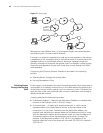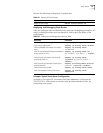
84 CHAPTER 5: IP ROUTING PROTOCOL OPERATION
user are managed together with the dynamic routes as detected by the routing
protocol. The static routes and the routes learned or configured by routing
protocols can be shared with each other.
Routing protocols (as well as the static configuration) can generate different
routes to the same destination, but not all these routes are optimal. In fact, at a
certain moment, only one routing protocol can determine a current route to a
single destination. Thus, each routing protocol (including the static configuration)
has a set preference, and when there are multiple routing information sources, the
route discovered by the routing protocol with the highest preference becomes the
current route. Routing protocols and the default preferences (the smaller the
value, the higher the preference) of the routes that they learn are shown in
Table 78.
In the table, 0 indicates a direct route, and 255 indicates any route from an
unreliable source.
Except for direct routing, the preferences of various dynamic routing protocols can
be manually configured to meet the user requirements. The preferences for
individual static routes can be different.
Routes Shared Between Routing Protocols
As the algorithms of various routing protocols are different, different protocols can
generate different routes. This situation creates the problem of how to resolve
different routes being generated by different routing protocols. The Switch 7750
supports an operation to import the routes generated by one routing protocol into
another routing protocol. Each protocol has its own route redistribution
mechanism. For details, refer to
“Enabling RIP to Import Routes of Other
Protocols”, or “Importing Routing Information Discovered by Other Routing
Protocols”.
Static Routes A static route is a route that is manually configured by the network administrator.
You can set up an interconnected network using static routes. However, if a fault
occurs in the network, the static route cannot change automatically to steer
packets away from the fault without the help of the administrator.
In a relatively simple network, you only need to configure static routes to make the
router work normally. The proper configuration and usage of the static route can
improve network performance and ensure bandwidth for important applications.
The following routes are static routes:
■ Reachable route — The normal route in which the IP packet is sent to the next
hop towards the destination. this is a common type of static route.
Table 78 Routing Protocols and the Default Preferences for Routes
Routing protocol or route type
The preference of the corresponding
route
DIRECT 0
STATIC 60
RIP 100
UNKNOWN 255


















